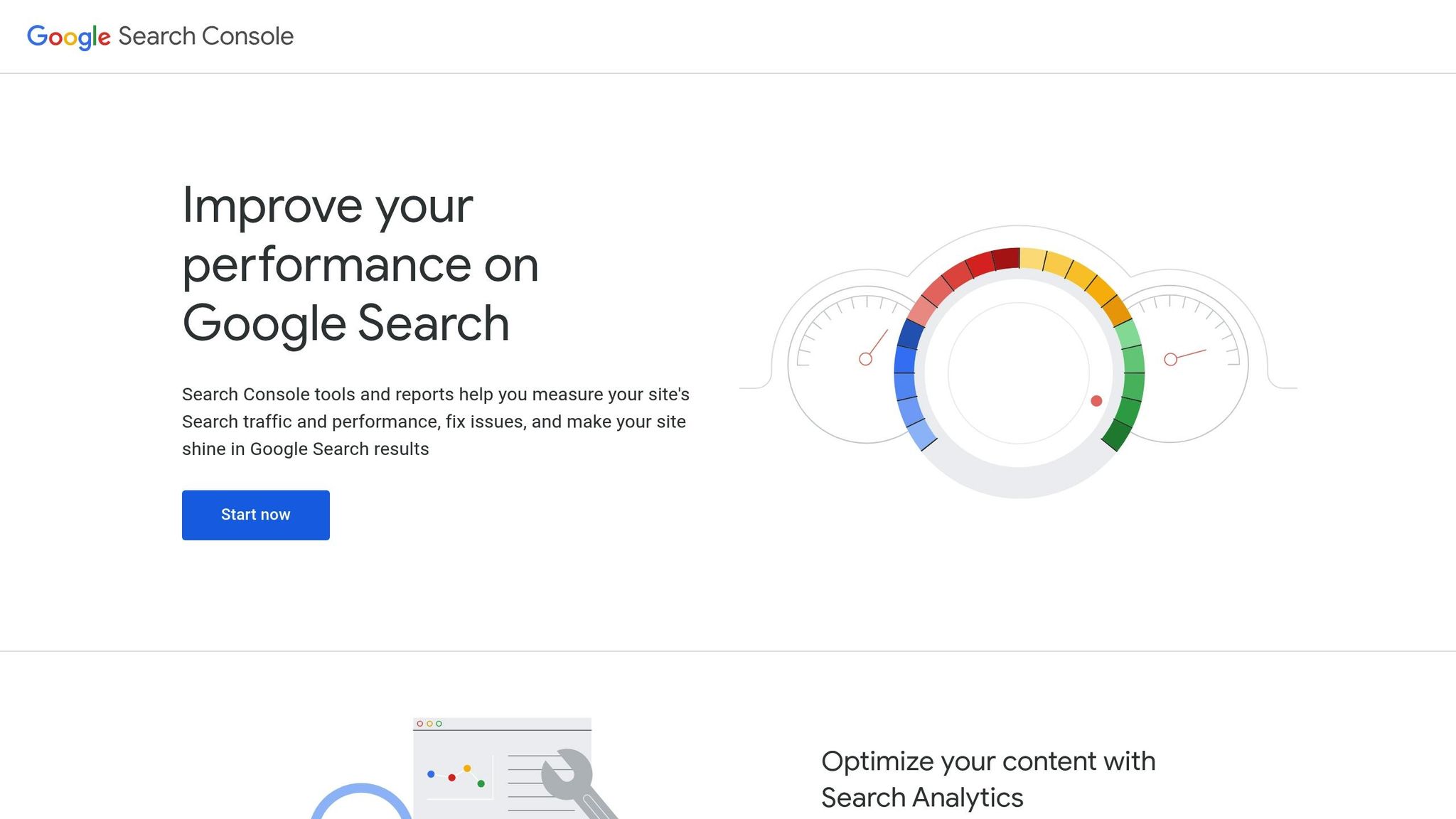Canonical tags help search engines understand which version of a webpage is the primary one, preventing duplicate content issues and improving SEO. But incorrect implementation can harm rankings, cause indexing errors, and dilute page authority. Here’s how to fix and manage them effectively:
- Audit Your Tags: Use tools like Google Search Console to identify duplicate content, conflicting tags, or incorrect canonical URLs.
- Fix Common Problems: Address issues like missing or broken tags, multiple tags on a page, and protocol mismatches (HTTP vs. HTTPS).
- Best Practices:
- Always use self-referencing canonicals unless pointing to a different URL.
- Place tags in the
<head>section of your HTML. - Use absolute URLs (e.g.,
https://example.com/page/) instead of relative ones.
- Monitor Regularly: Schedule weekly crawls, monthly reviews, and quarterly deep dives to ensure long-term performance.
Proper canonical tag management consolidates link equity, improves crawl efficiency, and stabilizes rankings. Use this checklist to keep your SEO on track.
SEO Best Practices for Canonical URLS + the Rel=Canonical …
Finding Canonical Tag Problems
Spotting issues with canonical tags requires a careful and structured approach, relying on a mix of tools and techniques.
Google Search Console Checks

Google Search Console is a great starting point for understanding how search engines interpret your canonical tags. Check the Coverage report, which flags pages with canonical-related problems. Pay attention to:
- Pages excluded from the index due to duplicate content.
- URLs with conflicting canonical tags.
- Instances where Google selects a different canonical than the one you specified.
For individual pages, the URL Inspection tool is invaluable. It lets you verify which canonical URL Google recognizes. Once you’ve reviewed these insights, follow up with a full website crawl for a deeper analysis.
Website Crawl Analysis
After reviewing Google Search Console data, conduct a site crawl to identify patterns and inconsistencies. Focus on:
- Self-referencing canonical tags.
- External canonical targets – ensure they’re intentional and correct.
- Protocol consistency (HTTP vs. HTTPS).
- Handling of URL parameters, such as those used for tracking or filters.
Common Tag Conflicts
Audits often reveal recurring problems with canonical tags. These include:
- Multiple canonical tags on a single page: This confuses search engines and can lead to unpredictable indexing results.
- Broken canonical links: Links pointing to non-existent or redirecting URLs waste valuable crawl budget.
- Incorrect implementation patterns:
- Canonicals pointing to paginated pages instead of the main page.
- Mismatches between different content formats.
- Category pages incorrectly canonicalized to the homepage.
Prioritize high-traffic pages and key revenue-driving sections during your investigation. Problems in these areas can have the biggest impact on your site’s overall performance.
sbb-itb-880d5b6
Fixing Canonical Tag Setup
To address canonical tag issues effectively, follow these steps with care.
Correct Tag Placement
Canonical tags should be placed in the HTML <head> section of your webpage. This ensures search engines can easily find and process them. Use the following syntax:
<link rel="canonical" href="https://www.example.com/target-page/" /> Place the canonical tag directly after the <title> and meta description tags for proper organization.
Avoid Common Mistakes
Here are some frequent errors to watch out for:
- Self-referencing canonicals: Every page should have a canonical tag pointing to itself unless it’s meant to reference a different URL.
- Canonical chains: Avoid creating chains where one page points to another, which then points to yet another. Each page should link directly to the primary version.
- Protocol mismatches: Always use consistent protocols, such as HTTPS, if available.
Now that you’ve addressed these issues, follow the rules below for proper implementation.
Tag Implementation Guidelines
Stick to these best practices when setting up canonical tags:
- Use absolute URLs: Always include the full URL, including the protocol and domain.
Correct: <link rel="canonical" href="https://www.example.com/page/" /> Incorrect: <link rel="canonical" href="/page/" /> - Handle URL parameters carefully: Remove unnecessary parameters like UTM tracking codes or session IDs, but keep essential ones that alter the content (e.g., filters for displayed products).
- Cross-domain setups: When working with cross-domain canonicals:
- Confirm ownership of both domains in Search Console.
- Ensure the target domain is crawlable by search engines.
- Keep canonical signals consistent across the domains.
Checking Canonical Tag Status
Keeping an eye on your canonical tags is essential to ensure they work as intended and support your SEO goals.
Schedule Regular Checks
Once you’ve fixed canonical tag issues, it’s important to maintain their performance with routine checks:
- Weekly Checks
Regularly crawl your website to spot any canonical tag problems. This is especially crucial after events like content migrations, URL updates, platform changes, or launching new pages. - Monthly Review
Review canonical tag setups across key areas like product pages, category pages, blog posts, and faceted navigation to catch any misconfigurations. - Quarterly Analysis
Take a deeper dive into more complex setups, such as cross-domain canonicals, regional site variations, and the relationship between mobile and desktop URLs.
Search Console Tracking
After resolving initial issues, ongoing monitoring in Google Search Console is a must. Problems like multiple indexed versions, duplicate content, conflicting canonical signals, or pages with multiple canonical tags can still arise.
Key tools in Search Console to keep tabs on canonical tag performance include:
- URL Inspection Tool
Use this to check how Google interprets individual pages and their canonical tags. - Coverage Report
Identify any indexing issues caused by canonical tag conflicts. - Index Status
Monitor overall index health and spot duplicate content warnings.
Measuring SEO Results
To gauge the success of your canonical tag optimizations, track these metrics:
- Organic Traffic: Keep an eye on traffic trends for pages marked as canonical.
- Crawl Efficiency: Look for fewer duplicate page crawls by search engines.
- Index Coverage: Check for a decline in duplicate content warnings.
- Link Equity: Ensure authority is consolidating correctly on canonical pages.
Summary and Checklist
Fixing canonical tag issues is key to keeping your SEO efforts on track. Use this checklist to tackle these problems step by step:
- Initial Audit
- Check canonical tags on all page types.
- Ensure self-referencing canonicals are in place.
- Verify tags are correctly located in the code.
- Identify and record duplicate URLs.
- Technical Assessment
- Confirm tag syntax is correct.
- Look for multiple tags on the same page.
- Ensure site-wide protocol consistency (e.g., HTTPS vs. HTTP).
- Check URL formats for uniformity.
- Implementation Review
- Make sure tags are placed in the head section.
- Verify URLs in tags match the intended format.
- Review custom or complex implementations.
- Test relationships between canonical tags.
- Monitoring Setup
- Use Google Search Console to track tag performance.
- Set up tools to monitor crawling behavior.
- Configure alerts for tag-related errors.
- Schedule regular audits to catch new issues.
If these steps don’t fix your issue, consider seeking professional help.
Professional Help Options
For persistent problems, SearchX offers specialized SEO services. Their canonical tag audit includes:
- A thorough review of your existing tags.
- Guidance on implementing fixes.
- Setting up monitoring tools.
- Tracking performance over time.
The SearchX team works with various platforms and systems to ensure your tags are set up correctly and continue to function properly. Their monitoring tools can catch issues early, saving you time and hassle.




